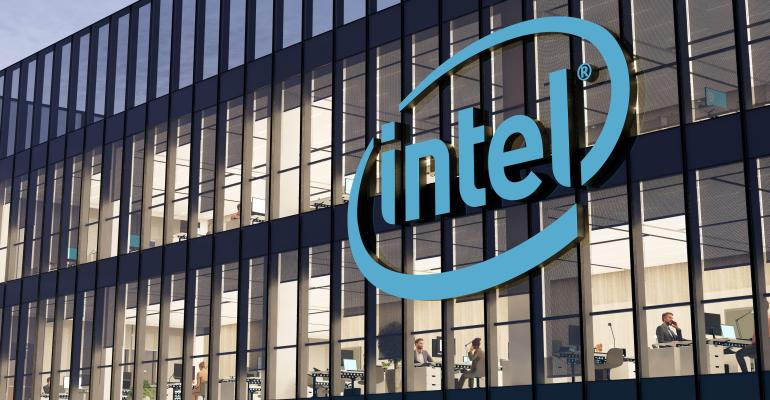This article originally appeared on Light Reading.
The performance of Intel's newish network and edge group never garners much attention when the giant chip shop publishes results. Accounting for less than 11% of Intel's revenues, it is dwarfed by the parts of Intel that produce chips for data centers and PCs. Most commentary does not dwell on the smaller unit. If Intel were a chip shop of the greasy British type, network and edge would be the mushy peas – of minor interest to all but aficionados, too squidgy and amorphous by far.
But Intel had grand ambitions for network and edge when it began promoting some of its mobile activities in 2019. During a hectic round of interviews, it told various trade publications it aimed to capture 40% of the global market for basestation silicon by 2022. This would be some achievement for a company that effectively had zero presence in the radio access network (RAN) just a few years before.
What percentage of network and edge sales Intel generates in this RAN market is not disclosed, but the overall unit has grown rapidly since results were first broken out. In 2020, Intel made about $7.1 billion in revenues from selling network and edge products. A year later, it was in touching distance of $8 billion, and turnover hit about $8.9 billion in 2022. But the mushy peas have fallen off the counter this year.
First-half sales plummeted a third, to less than $2.9 billion. And after recording a $710 million operating profit for the first six months of 2022, it suffered a $487 million loss. In its latest quarterly filing with the US Securities and Exchange Commission, Intel said that "customers tempered purchases to reduce existing inventories and adjust to a lower demand environment across product lines."
This is, essentially, the same explanation both Ericsson and Nokia offered when reporting weak second-quarter sales. And yet the impact on Intel, which sells chips to both Nordic vendors, looks far greater. On a constant-currency basis, sales at Ericsson's networks business were down just 13% year-on-year for the recent second quarter, while Nokia's mobile networks group managed 5% growth. After China's Huawei, which does not buy RAN chips from Intel, they are the world's two biggest vendors and therefore a decent market bellwether.
When the Chips Are Down
It's possible that Intel was hurt mainly by competition at the edge, where some companies are investing in advanced silicon to support artificial intelligence (AI) applications. Nvidia's graphical processing units (GPUs) are a direct threat to Intel's more general-purpose silicon in this area. Amid hype about ChatGPT and all its derivatives, demand for those GPUs has exploded, driving Nvidia's share price up 227% since the start of the year.

Weakness this year does not mean Intel necessarily failed to capture 40% of the market for basestation silicon in 2022 (Intel had not answered a question on this at the time of publication). Since 2019, there have been ups and downs for the company. The worst down was a major setback at Nokia after Intel missed delivery targets for 10-nanometer chips designed for the initial batch of 5G products.
Nokia, which appeared to have no other suppliers of customized 5G chips at the time, fell back on more expensive field programmable gate arrays (FPGAs), which temporarily upset its entire 5G strategy. It subsequently pivoted to Marvell as a supplier of baseband silicon for Layer 1, the most computationally intensive part of the RAN software stack, although Intel was retained for other layers.
Even so, Intel might have played a bigger role at Nokia today were it not for the 10-nanometer cock-up. The Finnish vendor is now building its virtual RAN portfolio around the use of Marvell for inline acceleration, a technique that offloads Layer 1 functions from the central processing unit (CPU) – typically supplied by Intel – to Marvell's chips. This Marvell commonality apparently allows Nokia to use the same Layer 1 software across purpose-built and virtual RAN products.
Stockholm Syndrome
The big up for Intel is an expanding relationship with Ericsson. Like Nokia, the Swedish vendor was outed back in 2019 as a customer of Intel's purpose-built, 10-nanometer 5G RAN chips, branded both Snow Ridge and Atom P5900 (Ericsson, curiously, seemed to avoid the delivery problems that tripped up its Finnish rival). In an update last week, Ericsson committed itself to using Intel in future as a contract manufacturer of customized 5G chips based on 18A, the codename Intel uses for one of its next-generation processes. Such chips will apparently use transistors measuring just 1.8 nanometers, smaller than anything currently on the market.
Separately, Ericsson is also all-in with Intel on virtual RAN, just as Nokia has pinned its fortunes on Marvell. Both Ericsson and Intel deride inline acceleration and its reliance on PCIe cards that slot into servers, arguing these are an additional cost and complication. Instead, they are pursuing a form of acceleration called lookaside. With this, only select Layer 1 functions are offloaded to a separate, custom chip. Both that and the CPU are supplied by Intel, meaning they can be more closely integrated and managed using the same Kubernetes toolsets.
All that said, the market for open and virtual RAN products has not taken off as quickly as advocates hoped, and the broader RAN market is now in a slump. Dell'Oro, a market-research firm, expects the RAN market to shrink by 13% this year in North America, historically the most profitable region for Ericsson and Nokia. In July, it also revised down its short-term expectations for open RAN, noting "some hesitancy about these next-generation architectures," although it still thinks open RAN will account for between 15% and 20% of total RAN sales by 2027. Other analysts are more bullish.
That suits Intel, which boasted a 99% share of virtual RAN deployments earlier this year. Even when inline accelerators are in use, Intel is the default option for RAN processing at Layers 2 and 3. The main threat here comes from AMD, a rival chipmaker using the same x86 architecture. In recent years, it has chomped into Intel's share of the market for data-center CPUs. Companies using the blueprints of Arm, a UK-based chip designer, are also on the march.
Operators want healthy competition, and yet few seem prepared to sacrifice performance and efficiency in the hunt for alternatives. That is probably a positive for a company as dominant as Intel is in computing. But the fortunes of its network and edge group in the next few years will hinge largely on whether companies believe it really is the best technology in town.






